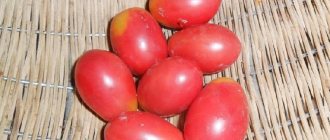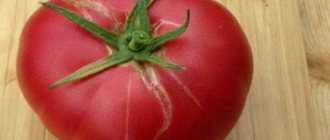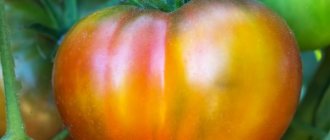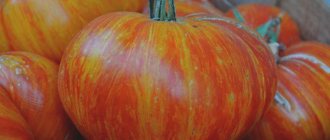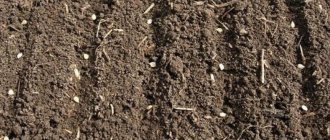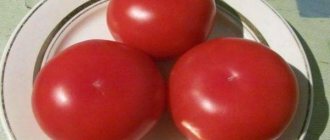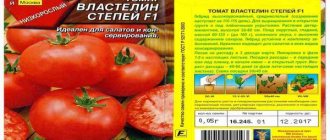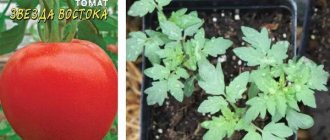The King of London tomato looks more like a tomato tree than an ordinary bush. This giant, two meters tall, is distinguished by large and delicious fruits, shaped like a heart.
Lovers of large-fruited varieties have long paid attention to it, planting it in their beds every year. Also considered a huge plus is the hardened Siberian character of the culture, which helps to survive and provide a rich harvest under any circumstances. Description of the variety, agrotechnical techniques and secrets of productivity - in the review of the article.
Description of the variety
Despite the name, the variety has nothing to do with England - it appeared thanks to amateur selection by Siberian scientists. It is not included in the State Register of Selection Achievements . But this does not prevent it from taking its rightful place among tomato crops and remaining a favorite among hundreds of gardeners.
Distinctive features
The type is indeterminate, the height of the bush is 1.5-2 m, the stem is strong, the root system is powerful . The foliage is moderate, the leaves are medium sized, light green in color. The inflorescences are simple, the first inflorescence is formed after the 9th leaf, the subsequent ones - every 2 leaves. Each brush forms 4-5 fruits.
Mid-early species , 105-110 days pass from the moment of sowing the seeds to full ripening.
The yield is high , up to 5 kg is harvested from 1 seedling, provided that no more than 3 plants are planted per 1 square meter. m.
It is distinguished by its stable immunity to the main diseases of the nightshade family, such as late blight, tobacco mosaic virus and powdery mildew.
The culture requires mandatory systematic pinching and tying up tall bushes.
Recommended for cultivation in open ground and greenhouse conditions.
Fruit characteristics
The fruits are large, average weight - 700-800 g, heart-shaped, pink or crimson in color .
The taste is excellent, sweet with a characteristic sourness, and has a high content of nutrients. The pulp is juicy, fleshy, the skin is dense. There are 6-8 seed chambers, few seeds. Universal purpose : the fruits are used for preparing various fresh dishes, cold and hot. For winter preparations, canning, marinades and pickling, vegetables have to be cut due to their large size. They are also excellent for processing into tomato products: juices, pastes, ketchups.
Ripe vegetables can be stored for a long time if the necessary conditions are created: the room should be dry and cool. Thanks to the dense peel, transportation over any distance takes place without loss of presentation.
The photo shows the King of London tomatoes.
It will be interesting:
Ideal for preservation and non-capricious “Japanese truffle”
An excellent variety for greenhouses and open ground - “Nastenka”
Variety for regions with cold climates - “Red Guard” tomato
Tomato “King of London”: medium-early and large-fruited
Looking at the “King of London” tomato reviews, photos, yields described by those who have already grown it, it becomes clear that the descriptions are very diverse and different. What's the matter? Yes, the fact is that such a variety is not in the register of breeding achievements of either the Russian Federation or other neighboring powers, and each packer packages what he considers necessary.
general information
When conducting a market survey on the shelves of seed stores and on the Internet resource, you can find both the King of London and simply London, which of course causes confusion and is unacceptable in the names of varieties. Consider the following “kings”:
- “King of London” from “Seeds of Altai”;
- “King London” Sverdlovsk region Russia;
- "Biotechnics" Russia;
- "Sadbrest" Belarus.
- “Siberian varietal seeds” Russia;
- Ukraine.
It should be noted that all these companies describe their selection masterpieces as folk selection.
Characteristics of what we have
Looking through the description, it becomes clear that all these descriptions have one thing in common - the tomatoes should be large-fruited. But everyone has their own vision of the “king” further.
Description of the variety
“Biotechnics” guarantees excellent taste, fleshiness and red color of fully ripened tomatoes, as well as excellent keeping quality until November, which is quite possible for a late tomato.
The yield of their “king” is within 5 kg per bush, but they claim that 10 kg per bush can also be taken.
- "Garden Brest". Claims that the tomato is bred in Russia, but does not indicate who exactly. Their “king” is mid-season, up to 160 cm high, and produces fruits from 350 to 600 g, and possibly up to 800. Fleshy, with a small amount of seeds, heart-shaped, raspberry-pink in color.
- “Siberian Varietal Seeds” have packaged something that will give a vegetative form of 180 cm with heart-shaped fruits of raspberry-red color. The average fruit weight is 300-500, but the manufacturer claims that individual specimens can produce 700-1000 g.
The tomatoes are fleshy, with excellent taste. The variety is recommended as a salad variety, as well as for use in processing.
- The variety presents itself as a well-leafed vegetative form up to 150 cm high. The tomato fruits are heart-shaped and weigh about 400 g.
The company guarantees that the tomatoes have excellent taste with a pleasant sweetness and a high solid content of pink-raspberry color.
Resistance to diseases and pests
It is impossible to determine the resistance of a variety without observations and laboratory studies. It is even more difficult to describe if the mismatch is simply huge.
Those vegetable growers who want to preserve the grown crop and not allow diseases and pests to take away part of it, do not look at the description of resistance, but regularly and timely treat tomato bushes with fungicidal preparations.
The first treatment is carried out as soon as the ovary appears, and then every 15-20 days with a constant rotation of antifungal drugs.
Advantages and disadvantages
Whatever manufacturer you choose, the advantage of this tomato is obvious - its large fruit.
And then it all depends on how lucky you are with the genetic variety.
All manufacturers indicate:
- high productivity;
- salad orientation of the variety;
- excellent taste.
Features of cultivation
All packers stated that the variety is tall and indeterminate. This suggests that the plant needs:
- grow through seedlings;
- when transplanting into the ground, plant lying down or very deep;
- steadily monitor the nutritional content of the soil;
- promptly plant stepsons and lead the culture in one shoot;
- Regularly tie up both shoots and fruit.
When evaluating the “King of London” tomato, the characteristics and description of the variety speak of very large fruits, even up to 1000 g. Looking at such data, it should be understood that it is impossible to get high returns from low-nutrient soils. Only balance in nitrogen, potassium and phosphorus can allow the plant to show its full potential and please the vegetable grower with a good harvest.
Feeding the bushes begins 10-14 days after planting the seedlings in open ground. The first fertilizing is carried out with a solution of nitrogenous fertilizers. The second is nitrogenous with potassium and phosphorus, and the third should be without nitrogenous compounds.
The ideal option for fertilizing can be chosen by alternating organic and mineral fertilizing, as well as root and foliar fertilizing. In this case, the plant receives balanced nutrition, which guarantees an increase in vegetative mass, resistance to diseases, and good yield of a high-quality harvest.
Video: 9 secrets of fruitful tomatoes
How to grow seedlings
Sowing seeds for seedlings begins 2 months before planting in the ground . All indeterminate types of plants are grown through seedlings, and this tomato is no exception.
Seed preparation
After careful inspection for visible defects, the seed is placed in a saline solution for 10 minutes . In this way, the emptiness of seeds is determined: those that float to the surface are not suitable for sowing. Then the seeds are disinfected in a weak solution of potassium permanganate for 20 minutes. After disinfection, they are washed with running water and dried.
To improve germination, the seed is germinated on damp gauze for 2-3 days . To do this, the grains are laid out on gauze slightly moistened with warm water and left in a dark and warm place at a temperature of at least 28°C. After the sprouts appear, the seeds are ready for sowing.
Reference. Germinating seeds on damp gauze significantly improves the germination rate.
Container and soil
The soil is prepared from garden soil, humus, peat and river sand in equal quantities . All components are thoroughly mixed and the resulting mixture is treated with a hot solution of manganese to destroy pathogenic flora.
Reference. Soil disinfection is a necessary and mandatory procedure for the healthy growth of seedlings.
The disinfected soil is laid out in planting containers, filling them halfway. As the seedlings grow, the remaining soil is added to containers, thereby providing additional enrichment of the root system with useful substances.
Planted both in a common box and in separate containers . When sowing in a common container, you must remember that in the future you will need to pick the plants, which can be avoided when planting in individual containers. In addition, plastic cups are convenient for transporting seedlings to a summer cottage.
Sowing
Seeds are sown to a depth of 1 cm with a distance of 2 cm from each other and sprinkled with soil on top . Lightly compact and water moderately with warm, settled water using a spray bottle. The planting containers are covered with film and left in a warm room at a temperature of 22-24°C.
The film is periodically removed to ventilate the soil. As the top layer dries out, the soil is moistened with warm, settled water.
Growing and care
When seedlings appear, the containers are moved to the windowsill . The duration of daylight for seedlings is 14-15 hours, so additional lighting is installed in advance. Water the seedlings moderately, without flooding the sprouts, with warm, settled water using a shallow watering can. After watering, the soil is loosened, thereby providing oxygen to the young roots.
When 2 true leaves appear, the seedlings dive , planting them in separate containers. The picking procedure involves removing the main root by one third, after which the lateral roots are intensively grown. During picking, weak plants are disposed of, leaving only strong and healthy bushes.
Reference. If seedlings are left in a common container after picking, it is necessary to increase the distance between seedlings to 15 cm.
During picking, the bushes are fed with liquid fertilizer for tomato seedlings.
2-3 weeks before transplantation, the seedlings are hardened off by taking them out into the open air for 1 hour during the daytime. Gradually this interval is increased to 12 hours, while simultaneously reducing the night temperature in the room to 13°C.
SIBERIAN TOMATO VARIETIES ZHENKA, KING LONDON, DIMENSIONAL
Plant care
In order for the yield to be high, it is necessary to ensure proper care of these crops. Descriptions of care can be found in gardening books or on Internet sites.
The most important thing for tomatoes is watering. Tomatoes of the King of London variety should be watered generously and preferably not with cold water. This could be water from a barrel, pond water or rain water. But you shouldn’t flood the beds either, the roots will begin to rot and hurt.
It is necessary to open doors and windows in greenhouses more often on hot days. This is how air circulation and hardening occurs.
Loosening the soil and hilling it up is also necessary. The soil should be soft and light. On good land there will always be a good harvest. And don’t forget about weeds, they interfere with the supply of useful substances to cultivated plants, and also take all their strength.
To prevent insect pests, you need to spray the bushes with special solutions, thereby creating an unfavorable environment for them. Typically, tomatoes are attacked by bugs, spider mites, aphids, butterflies and mole crickets.
Tomatoes bear fruit well only in soil with plenty of fertilizer. Feeding is important at different stages of growth, starting from planting the seed. Before planting in a greenhouse, humus, manure, chicken droppings, and sand are added to the soil. Then, during the flowering and growth process, organic fertilizers are needed.
As a result of careful care, summer residents receive abundant fruiting of smooth, fresh fruits with a rich taste.
How to grow tomatoes
After two months, the seedlings are ready for transplanting . By this time, the bushes already have 5-7 true leaves and a fully formed root system.
Landing
The soil is prepared in advance by digging and applying complex fertilizers.
Planting pattern : 50 cm – distance between seedlings, 70 cm – row spacing. For 1 sq. m place 3 plants.
Transplant on a cloudy day or in the evening into holes 20 cm deep . After transplantation, they are watered generously with warm, settled water and left to adapt to new conditions for 8-10 days.
Reference. While getting used to new conditions, the bushes are not watered or fed.
Further care
The main attention in caring for this variety is given to watering . Water generously with warm, settled water, strictly at the root, without getting on the leaves. However, it is strictly not recommended to flood the plants: the roots do not like excess moisture and can rot. On dry days, the amount of watering is increased, preventing the soil from drying out, and watering is stopped during fruiting.
After watering, the ground is loosened, removing weeds with roots .
Weeds take a lot of nutrients from the soil, which are so necessary for the full development of cultivated plants, so the proximity of tomatoes to weeds is not desirable. In addition, weeds are the cause of most fungal infections. To keep moisture in the beds longer, they are mulched with peat or straw .
This is especially necessary on hot days when moisture evaporates quickly. To obtain excellent large fruits, it is important to follow the feeding regime :
- 2 weeks after transplantation, the plants are fed with nitrogenous fertilizers. After adding nitrogen, plants intensively increase their green mass, which is necessary for healthy growth.
- During flowering, complete complex mineral fertilizers or organic matter are used. From organic matter, use mullein infusion or bird droppings in a ratio of 1:15.
- At the moment of fruit set, they are fed with phosphorus-potassium fertilizers for faster ripening of vegetables.
Features of cultivation and care
Despite the fact that the King of London is not considered a hybrid, you should not collect seeds from grown fruits. Even if they sprout, they will no longer have the same quality. Therefore, every year you will have to buy a new bag of seeds.
The variety is not sown in open ground - seedlings are first grown. The following points are taken into account:
- the seedling container must be spacious enough - you must immediately maintain a distance between the seeds (due to the branched root system);
- It is better to use a special purchased soil mixture;
- Picking in separate containers is carried out when the sprout has 2-3 true leaves.
Temperature, light, and irrigation regimes do not differ from those used for the crop as a whole.
Transplanting
Planting in beds is carried out in May or June (depending on the region). It is important to wait until the risk of return frosts is eliminated. The soil in the garden must warm up well, otherwise the seedlings will take a long time to take root.
The soil is prepared in advance by plowing or digging. Complex fertilizers are added during the process. The seedlings must be strong, without signs of disease and with a well-developed root system.
The seedlings are planted deep into the hole or placed at an angle. When forming holes, maintain a distance between them of at least 40 cm. If the bushes are grown into 1 stem, then per 1 sq.m. make 4 holes, for 2 stems - 3 pcs.
Care
Although the King of London is considered unpretentious, it is better to provide decent care in order to get a big harvest:
- the main attention is paid to watering - it should be plentiful; but you shouldn’t flood the beds either, so that the roots don’t rot; when growing in a greenhouse, the best option is drip irrigation;
- for irrigation it is recommended to use rain, pond, and warm water;
- In order for the roots to develop well and the bush to receive adequate nutrition from the ground, the soil must be soft; therefore, loosening is carried out as often as possible;
- the variety does not like being adjacent to weeds - weeding should become a regular step in caring for tomatoes;
- due to the ability of the bush to branch, it is necessary to carry out pinching, forming a plant of 1-2 stems;
- the height of the bush and the size of the fruit dictate the installation of a trellis, which is best taken care of in advance; It is necessary to tie up not only the stems, but also the ripening fruits
- The King of London is responsive to fertilizers; To get large fruits, fertilizing is applied to the plants according to the following scheme:
- 2 weeks after planting in the ground, nitrogen fertilizers are used;
- during the flowering period - complex;
- at the time of fruit formation - phosphorus-potassium;
- the ideal option is to alternate mineral fertilizers with organic ones (chicken manure, cow manure);
The King of London is resistant to diseases, but the variety does not have immunity from pest attacks. To prevent the appearance of mole crickets, spider mites, aphids, butterflies and bugs, the beds are periodically treated with special means.
The nuances of breeding in open ground and greenhouses
The crop is planted in open ground in the southern regions . In areas with a temperate climate, cultivation under film is recommended, and in the northern regions - only in greenhouse conditions.
In greenhouses, the weight of ripe vegetables exceeds those grown in open beds . The yield is also higher here - up to 8 kg is harvested from 1 seedling.
The growth of greenhouse plants reaches 2 m , so pinching the crown is indispensable. This procedure is needed to indicate the growth point, since under favorable conditions the indeterminate type grows continuously.
Closed structures are regularly ventilated so as not to exceed the permissible humidity level. Otherwise, there is a risk of developing fungal spores and damaging plants with various infections. In addition, due to moisture disturbances, the fruits crack. If cracks appear, they must be coated with vegetable oil.
Characteristics and description of the King of London tomato variety, its yield
The King of London tomato is famous for its large fruits of unusual shape and resistance to various diseases. The characteristics of tomatoes allow you to determine how to properly care for them and what conditions to provide for good fruiting. The King of London is a hardy tomato that produces a good harvest and ripens in late summer. The variety was first bred in Siberia. He is not a hybrid.
What is the difference between the variety
The description of the variety can be read on the package of seeds purchased in the store. Seeds cannot be bred independently; they are bought every year. This variety bears fruit 100 days after planting the seeds. This plant grows best in greenhouses and is planted as seedlings. If the summer is hot, then you can plant it in an open space, just cover it with film.
The bush grows quite tall, up to two meters. The stem is dense with developed foliage. The root is branched and capable of growing in breadth. The color of the leaves is bright green.
Harvesting and application
Ripe vegetables begin to be collected in July . Large fruits are of the salad type, so they are ideal for fresh consumption. They are used to prepare excellent summer salads, vegetable stews, and hot dishes: soups, stews with vegetables and meat. As for canned food, vegetables have to be cut due to their large size. Therefore, they do not try to make winter preparations from them. But they are allowed to process tomato products, since tomatoes perfectly retain sourness in juices, pastes, adjika and ketchup.
Thanks to their thick skin, ripe vegetables can be stored for a long time in a cool, dry place, until November. This is undoubtedly a big plus, since you can pamper yourself with fresh summer salads all fall.
Characteristics
"King London" has the following advantages:
- large fruits;
- high productivity;
- long storage;
- taste;
- resistance to major diseases.
Among the disadvantages, frequent cracking of the fruits on the plant is noted. They are valued for their very large sizes - more than 15 cm in diameter, and can weigh more than 1 kg with good care. Average weight is about 800 g. The fruits have a round shape with an elongated nose - heart-shaped. The skin is dense, not thick, smooth.
You can compare the weight of fruits with other varieties in the table below:
| Variety name | Fetal weight |
| King London | up to 800 grams |
| Doll | 250-400 grams |
| Summer resident | 55-110 grams |
| Lazy | 300-400 grams |
| The president | 250-300 grams |
| Brawler | 100-180 grams |
| Kostroma | 85-145 grams |
| Sweet bunch | 15-20 grams |
| Black bunch | 50-70 grams |
| Stolypin | 90-120 grams |
The color of unripe fruits is pale green, mature ones - from pink to crimson. The pulp is pink, fleshy, tender with a large number of chambers, up to 8, for seeds, which are few. Dry substances were found in small quantities. The taste is excellent, sweetish with a “tomato” sourness, very aromatic.
The content of nutrients has been increased. Tomatoes have an excellent taste, they can be consumed fresh, in sandwiches, raw salads. They do not lose their aroma and vitamins during heat treatment - in soups, when stewing. Canning and salting only when chopping. Suitable for the production of tomato sauces, pastes and juices.
Advantages and disadvantages
Culture has many positive properties:
- adaptation to weather conditions;
- high resistance to diseases;
- ease of care;
- high fruiting rate;
- mid-early maturation;
- excellent taste;
- large fruits;
- universal purpose;
- long storage;
- long transportations.
Negative properties include:
- regular stepsoning;
- obligatory garter;
- cracking of fruits due to high humidity.
Brief information about the variety
- Fruits and bush : tomatoes are red-raspberry in color, heart-shaped, weighing from 200 to 600 g; indeterminate bush, 100-200 cm high.
- Productivity : high (from 6 to 10 kg of fruits per bush).
- Resistance : high to most diseases.
- Distribution : in the south it can be grown in open ground, in the middle zone and in the north - in greenhouses.
- Application : salads, slices, main courses, processing.
- Planting : seedling method; sowing seedlings - in mid-March, transplanting into a greenhouse - in mid-May; planting pattern – 50×60 cm.
- Soil : light, loose, fertilized with organic matter.
- Care : watering - once every 7-10 days, fertilizing - 2 times a month, formation - 1-2 stems, tying - required.
- Ripening period: mid-early - fruits are harvested 105-110 days after seed germination. Ripe tomatoes last about a month, slightly unripe ones - a month and a half.
Farmer reviews
Judging by the opinions of gardeners, the culture is very popular among gardeners .
Yulia, Odessa : “The variety is tall, the bushes have grown 1.8 m. Despite the fact that I did not completely plant them, the harvest turned out to be large. The fruits weighed 500-600 g, so one tomato is enough to prepare a salad for two people. I was especially surprised by the taste – real, tomato.”
Georgy, Chelyabinsk : “I was visiting a friend, and he showed me photographs of his favorite tomatoes. I immediately noticed the massive bushes with huge heart tomatoes. I planted it in my greenhouse. Watered and fed infrequently. The vegetables are ripe, delicious, meaty and without unpleasant veins. Very satisfied!".
Tomato Burkovsky early - description and characteristics of the variety
Tomato Burkovsky early is a high-yielding determinate variety. The bushes grow up to 60 cm and require removal of the shoots and tying up. Fruiting occurs 90-95 days after emergence. The variety is unpretentious, tolerant to late blight and viral diseases of nightshade crops.
Description
The crop is grown by seedlings. The fruits are round, juicy, rich red in color with excellent taste. Early Burkovsky tomatoes are consumed mainly fresh. Tomato seedlings grow for no more than 50 days. In the middle zone of the country, seedlings are planted at the end of May, under temporary shelters. Seeds germinate in up to 10 days. This means that you need to sow seedlings no earlier than March.
Seedlings are the basis of the tomato harvest
Early Burkovsky tomatoes tolerate picking well. Sow the seeds immediately into separate cups with a volume of at least 500 ml. Fill the cups 2/3 full with soil and plant the pre-soaked seeds to a depth of no more than 1 cm. Water them with water. Plant 2-3 seeds in each cup. After germination, weak plants are removed. Only one strong sprout is left.
Grow seedlings on a windowsill with good lighting. The optimal temperature during the day is 18 degrees, and at night below 16. At high temperatures, seedlings stretch out. Caring for seedlings involves regular but moderate watering. To protect against waterlogging, make drainage holes in the cups. Excess moisture comes out through them.
Planting seedlings in open ground
Strong and healthy seedlings are transplanted into open ground. Planting begins in late May or early June.
- In the prepared bed, make holes at a distance of 50 cm. Carefully remove the seedlings from the container and plant them in the holes without deepening them.
- Water with warm water. A peg is driven in nearby and the plants are tied with a rope. If there is a threat of frost, cover the bed with tomatoes with non-woven covering material. If possible, the soil is mulched with humus or peat.
- Basically, caring for tomatoes grown from seeds and those grown from seedlings is almost no different from each other. It consists primarily of loosening, which must be carried out between rows.
- It is especially necessary to hill up the bushes during flowering and the appearance of the ovary. At the moment when the leaves are closing, no work related to the soil can be carried out.
- Before planting seedlings in the ground or sowing seeds, the soil must be fertilized with a small amount of nitrophoska, about ten grams per square meter.
During planting, make sure that the plants are immersed in the soil as deeply as possible in order to form additional roots. After planting, the seedlings must be protected from direct sunlight for a couple of days. The early Burkovsky tomato feels comfortable in porous and permeable soil. In the early stages of cultivation, timely watering is very important.
Proper care of tomatoes is the key to a large harvest
- It is better to use herbal infusion and ash as a top dressing. These are environmentally friendly fertilizers. Although you can also use mineral fertilizers. But many gardeners are already abandoning them.
- To retain moisture in the soil, it is recommended to place mulch between the bushes. Straw, sawdust or grass are excellent as mulch.
- It is impossible to get a good harvest of tall tomatoes without proper formation of the bush.
Be sure to trim excess stepsons. In order to obtain large fruits, about three healthy shoots and no more than 10 ovaries are left.
Harvesting
The fruits are harvested at the end of June. The color of ripened fruits must correspond to the selected variety. The fruits are cut together with the stalk using sharp pruning shears. The collected fruits are stored in a cool place, protected from light. But it’s better to use them right away for making salads.
Advantages and disadvantages
Reviews of the King of London tomato are mostly positive. And this is quite understandable, because these huge fruits do not require intricate care and ripen even in cold conditions. Among the advantages are high yield and endurance. This plant bears fruit well despite fluctuations in temperature, wind, frost, and is immune to many diseases. The fruits have an incredible aroma and taste. Everyone knows their properties to strengthen the immune system and participate in metabolism.
